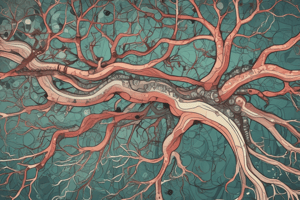Podcast
Questions and Answers
What is the primary function of microglia cells in the CNS?
What is the primary function of microglia cells in the CNS?
- To pass chemicals between neurons and blood
- To remove waste material and foreign substances (correct)
- To guide the migration of neurons during embryological development
- To form the myelin sheath around axons
Which type of glial cell is responsible for forming the myelin sheath in the PNS?
Which type of glial cell is responsible for forming the myelin sheath in the PNS?
- Schwann cells (correct)
- Ependymal cells
- Astrocytes
- Oligodendrocytes
What is the function of astrocytes in the CNS?
What is the function of astrocytes in the CNS?
- To guide the migration of neurons during embryological development
- To remove waste material and foreign substances
- To pass chemicals between neurons and blood (correct)
- To form the myelin sheath around axons
What is the term used to describe the collective group of supporting cells in the CNS and PNS?
What is the term used to describe the collective group of supporting cells in the CNS and PNS?
Which type of glial cell is responsible for guiding the migration of neurons during embryological development?
Which type of glial cell is responsible for guiding the migration of neurons during embryological development?
What is the function of ependymal cells in the CNS?
What is the function of ependymal cells in the CNS?
What is the primary function of oligodendrocytes in the CNS?
What is the primary function of oligodendrocytes in the CNS?
What is the role of astrocytes in the formation of synapses in the CNS?
What is the role of astrocytes in the formation of synapses in the CNS?
Flashcards are hidden until you start studying
Study Notes
Neuroglia (Glial Cells)
- Neuroglia, or glial cells, are supporting cells in the PNS and CNS that provide structural and metabolic support to neurons.
- They remove toxic debris and secrete anti-inflammatory factors, ensuring the health of neurons and maintaining the structural integrity of the nervous system.
Types of Glial Cells
- Astrocytes:
- Have extensions that surround both blood capillaries and neurons.
- Have extensions adjacent to synapses, appearing to be necessary for the formation of synapses in the CNS.
- Pass chemicals back and forth between neurons and blood and among neighboring neurons.
- Microglia:
- Are phagocytic cells that remove waste material and other microorganisms that could harm neurons.
- Migrate through the CNS, phagocytosing foreign and degenerated material, and are considered immune cells of the CNS.
- Oligodendrocytes:
- Build the myelin sheath that surrounds the axon of some neurons in the CNS.
- Produce myelin sheaths that insulate certain vertebrate axons.
- Schwann cells:
- Have a similar function to oligodendrocytes, building the myelin sheath that surrounds the axon of some neurons in the PNS.
- Radial glia:
- Guide the migration of neurons and the growth of their axons and dendrites during embryological development.
- Ependymal cells:
- Form the epithelial lining of ventricles (cavities) in the brain and the central canal of the spinal cord.
- Form choroid plexuses structures that produce cerebrospinal fluid.
Studying That Suits You
Use AI to generate personalized quizzes and flashcards to suit your learning preferences.




